Type the name of the breed you're looking for below
[wpdreams_ajaxsearchlite] Don't see the breed your're looking for? Click here and let us know!
Russian Sand Boa
| Place of Origin and Range | The species is endemic to Asia |
| Description | This Boa has a dark brownish banding extending over the top of the body. Colouration varies from tan, buff, grey, or yellowish ground colour. With Blotches on the sides. |
| Morph Patterns Available | Yes |
| Adult Size | Can grow up to 2ft (0.6 m) |
| Accommodation | A desert savannah with 3-5 inches of sand to allow for burrowing. You will want to include a large dish for bathing and soaking in to improve shedding. Always include a day basking spot at 80'F(27'C). Along with multiple hides. Minimum 2 x 2 x 4 feet for an adult. |
| Lifespan | Can live 12+ years |
| Feeding / Diet | Like most snakes a this Boa can eat mice, rats, and rabbits depending on the size of your snake and the availability of feed. |
| Breeding | Viviparous they breed readily November through April in the United States delivering live birth averaging 10-20 babies born spring through late summer. The young at birth typically are 20–25 cm (8-10 inches) in length. |



